Timeline
(c) 1985 by George Marino
Introduction
Here is some background on "Timeline" from George Marino:
I am sending you what I feel is a unique chess variation. It is to my knowledge the first 4-dimensional chess game that is completely symmetric and mathematically correct. The game, "Timeline" has been reviewed in "Games" (April, 1986), an American magazine, and in "Spielbox" (March/April, 1995), a German magazine. I have been running tournaments in this game at game conventions since 1985.
[George Marino is also the creator of "Pentaplane" which is mentioned in "The Encyclopedia of Chess Variants" by D. B. Pritchard. -DH]
With the conquest of air and finally space, classical two-dimensional warfare became three dimensional. The conquest of time added more than a dimension; it changed the entire concept of war. Time warriors did not confront one another. They traveled to each other's past and made changes. A time warrior studied the life history of his opponent to find a weakness. That is, he studied his opponent's TIMELINE.
Object of the Game
Timeline is a two-player game. Each player moves one of his team of pieces each turn. Turns alternate. Each player attempts to capture enemy pieces. A player captures an enemy piece by placing his own piece onto the timeline of the opponent's piece. A player can regain a captured piece by capturing his captor "before" the original capture took place. Here, "before" means earlier on the captor's timeline. Movement is through a 4-dimensional space-time continuum.
The Board
The board consists of four 3-dimensional reduced chess boards. Reduced means that they are 4 X 4 X 4 rather than 8 X 8 X 8. One 3-D board is labeled Monday, one is labeled Tuesday, one is labeled Wednesday, and the last is labeled Thursday, Time-travel (as well as diagonal time-travel) is permitted. For convenience, the board is drawn in perspective, but it is printed on a flat surface. The following figure depicts the board:
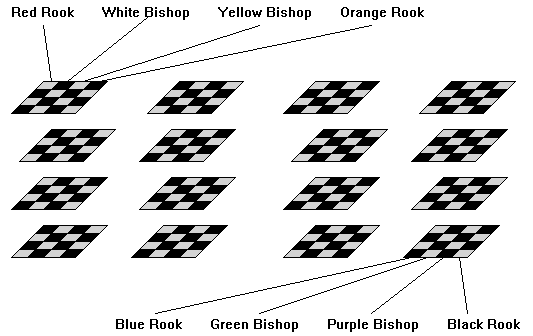
The Pieces
Each player has two rooks and two bishops. Since each piece will leave a trail on the board (the trail is the timeline of the piece), each piece is a different color. Thus, one player has a black rook, a blue rook, a green bishop, and a purple bishop. The other player has an orange rook, a red rook, a white bishop, and a yellow bishop. Each player will also have enough colored chits (little squares of colored paper) to mark the timeline of each piece on the board.
The Movements
A single-space rook move is one space forward, backward, left, right, up, down or to an adjacent timeboard while in the same three-dimensional position. Rook R below can move into any of the Xed positions with a single-space rook move:
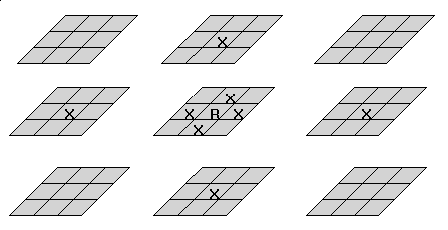
Notice that a single-space rook move will always take the rook to a square of a different color.
In one turn, a rook can be moved one, two, or three single space rook moves in the same direction. (More than that would take it off the board.) A piece cannot be moved off the board.
A rook may end its move on a square containing an opponent's piece or on an opponent's timeline. In both cases, the opponent's piece is captured (explained later.) But a rook cannot cross over any timeline in one turn. When a rook lands on an opponent's timeline, it must stop its movement for that turn.
A player cannot move a piece into a square containing another of his pieces or a timeline of one of his own pieces. A time warrior is not permitted to meet himself - or any of his teammates - in his own past. This creates many squares into which pieces cannot move.
A single-space bishop move is shown below:

A single-space bishop move could be described as the result of two single-spaced rook moves at right angles. (The time direction rook move is considered at a right angle to any three dimensional rook direction.) A bishop cannot move in a direction requiring three right angle rook moves.
Notice how a bishop is restricted to squares of a single color.
In one turn, a bishop can be moved one, two, or three single-space bishop moves in the same direction. (More than that would take it off the board.) A piece cannot be moved off the board.
A bishop may end its move on a square containing an opponent's piece or on an opponent's timeline. In both cases, the opponent's piece is captured (explained later.) But a bishop cannot cross over any timeline in one turn. When a bishop lands on an opponent's timeline, it must stop its movement for that turn.
Remember, a player cannot move a piece into a square containing another of his pieces or a timeline of one of his own pieces. A time warrior is not permitted to meet himself - or any of his teammates - in his own past. This creates many squares into which pieces cannot move.
Initial set-up
Each piece is placed in the indicated square with one timeline chit of the same color under it. The player with the warm colored pieces (white, yellow, orange, red) moves first.
Timelines
A timeline marker is a little square of colored paper - a chit - which is the same color as the piece whose path it marks. These chits will mark the paths of the pieces throughout the entire game.
Every square through which a piece moves is marked with a chit the color of the piece. On the square in which the piece ends its movement, the chit is placed under the piece. The path of chits of a single color is called the timeline of the piece of that color. When the underlined word "before" is used hereafter, it will mean earlier (or more towards the beginning) of the piece's timeline. "After," underlined, will mean later (or more towards the present position of the piece) on the timeline. If the movement of a piece becomes complicated, numbered chits may be used.
Notice that before and after have nothing to do with the words Monday, Tuesday, Wednesday, and Thursday at the bottom of the board. Before and after strictly refer to towards the beginning or towards the end of the timeline of the piece. Local time does not affect a time warrior.
Capturing
If a piece lands on an opponent's piece or on the timeline of an opponent's piece, the opponent's piece is captured. Not only is the captured piece removed, but all the opponent's piece's chits after the square of capture are removed. Thus, the opponent's piece's timeline now ends on the capture square. The square of the capture now has two chits in it as well as the piece that made the capture. Later, since one timeline now ends here and another timeline goes on (or at least is covered by the captor,) a record of the capture lies before the players on the board.
But a piece may be "uncaptured" (released) and placed back on the board at the end of its timeline. This happens when the captured piece's captor is itself captured by a third piece before (earlier on its timeline) it made the original capture.
Time warrior A may have been eliminated by a time change caused by enemy X. But A's buddy B initiates another time change, further in X's past, which causes enemy X not to exist when the first change occurred. Warrior A pops back into existence on the time-place square on which he was originally eliminated (at the end of its timeline.)
Even if a piece is captured, it may be captured again earlier on its timeline.
Release of Lost Pieces
A piece remains captured only as long as the end of its timeline contains the chit of an enemy piece. Such a chit will be removed if the piece that owns the chit were captured earlier on its timeline.
Whenever the chit of a piece is the only thing in the square at the end of its timeline, the captured piece is replaced at the end of its timeline. Thus a piece is returned to the end of its timeline when its captor is captured before it made the capture. Here before means earlier on the capturing piece's timeline.
The example game should clarify all this.
Safe Squares
Notice that a piece is "safe" in the square where is made a capture because the timeline chit of the captured piece still lies in this square. Since an opponent's piece cannot enter a square containing a timeline chit of his colleague, the opponent cannot enter this square. This is an important strategical consideration.
But, of course, the "safe" piece is only safe in that square. Its past is still vulnerable. It can be captured when an opponent moves onto one of its earlier timeline chits if that chit is the only chit present in that square.
Rational
Time travel is a funny thing. Time warriors had to be restricted from meeting themselves in their own past. The results would be too paradoxical. Likewise they are forbidden to visit a fellow time warrior in his past. They may only visit the past of an enemy.
Winning
A player wins when all his opponent's pieces are captured and off the board at the same time. The game is a draw when each player has only one bishop, and they are on opposite colored squares, and neither bishop can release another piece.
Example
For simplicity, this example is two-dimensional. However, you may consider its plane to be vertical or horizontal. Or consider the example to be one row on four different days. The example is equally valid for all these cases.

- The example starts with the board in this position:
- It is player A's turn. Player A moves the red rook as shown, its path
being marked by red timeline chits:
- It is player B's turn. Player B moves his black rook as shown, its
path marked by black chits. Since the black rook lands on the red rook's
timeline, the red rook is captured. Both the red rook and the part of the
red rook's timeline after the capture are removed.
- It is player A's turn again. Player A moves his yellow bishop ending on the black rook's timeline. The black rook and the part of the black rook's timeline after the capture are removed. But this action frees the end of the red rook's timeline. The red rook is no longer captured so it is returned to the board at the end of its timeline.
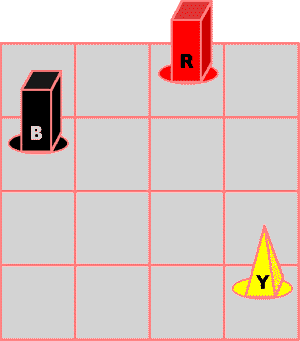
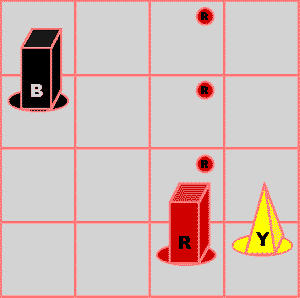
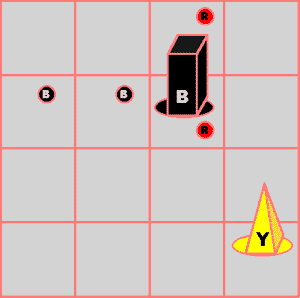
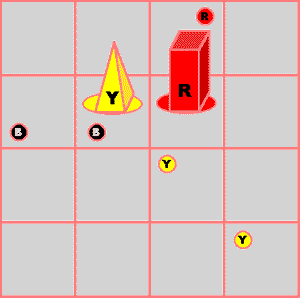
Cases
Case I
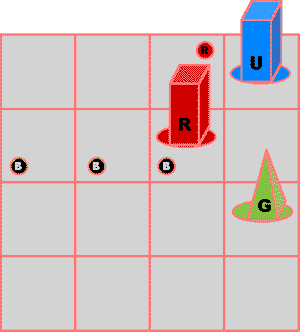
The red rook has captured the black rook. Oddly, the green bishop cannot capture the red rook. Doing so would necessitate having the green bishop land on a square containing a timeline chit of his own team. This is specifically forbidden. (The square containing the red rook contains a timeline chit of the black rook. While this chit is in that square, the green bishop is forbidden entry to that square.)
However, the blue rook may capture the red rook by landing earlier on
its timeline.
Case II

It is the warm colored player's turn to move. He sees that the blue
rook will capture the red rook next turn, which will result in the return
of the black rook (which has earlier been captured by the red rook.) Warm
colored player does not want this rook returned to the board, so his white
bishop captures the already captured black rook - but earlier on its timeline.
Now the board looks like the one below, and the blue rook cannot empty
the end of the black rook's timeline of a warm colored chit. Now the blue
rook cannot free the black rook next turn.

Playtesters
Many thanks to David Dolnics, James Fitzgerald, George Gilewski, David Marino, Linda Marino, Loran Riddle, Lawrence Stilwell, and Robert Warda.
Questions
If you have any questions write to:
Geo Games24 Tupelo
Naperville, IL 60540
Written by George Marino. Edited by David Howe.
WWW page created: September 2, 1997.